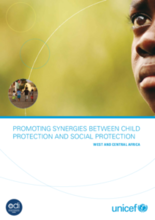At the core of social protection is a concern for addressing vulnerability and risk. It is increasingly understood that social protection policy frameworks and programmes must be informed by a recognition of the diversity of vulnerabilities and risks, and the way in which these evolve across the lifecycle. This report focuses on children’s vulnerabilities and risks related to an absence of protection from violence, abuse and neglect, and the ways in which measures to address such vulnerabilities and risks can be more effectively integrated into social protection policy frameworks in the West and Central Africa region. The analysis is based on a desk review as well as the findings from five in-depth country cases: Congo, Equatorial Guinea, Ghana, Mali and Senegal.
Seven major drivers of children’s protection-related vulnerabilities are identified. Economic poverty and experience of household and community-level shocks represent a first major driver of protection violations, which may be manifested in terms of child labour, child trafficking or commercial sexual exploitation, and in some cases heightened likelihood of family violence. Rapid urbanisation and economic globalisation have also had a major impact on informal social protection mechanisms and are a second major driver of children’s vulnerability and risk of violence, abuse or neglect.
A third factor relates to discriminatory socio-cultural attitudes about age, which are often compounded by gender, indigenous or ethnic minority status, disability and sexuality. The social exclusion arising from such attitudes can reinforce other economic or social inequalities and risks, including lack of access to basic services, justice and livelihood sustenance. Key child-specific manifestations include corporal punishment against children and sexual violence in the home, school or community. A fourth, related, driver is that of harmful traditional or religious attitudes and practices, which remain deeply entrenched in many parts of the region. These include female genital mutilation and cutting (FGM/FGC), the bonded labour of children in religious institutions and child marriage.
The fifth driver is that of armed conflict, which has been and continues to be key underpinning factor of protection-related violations and related consequences for children in the region. This manifests itself in the form of children associated with armed forces and armed groups (CAAFAG) as well as child victims of other forms of physical and sexual violence and harmful forms of child labour. Institutional weaknesses are identified as the sixth driver; here, the analysis focuses on the failure of state institutions to provide adequate protection, from limited access to birth registration to insufficient child-specific provisions within the justice system. The final driver is that of health shocka and chronic illness, especially HIV and AIDS, which have left millions of children orphaned in the region.
An overview of existing child protection systems in West and Central Africa underscores some of the challenges they face in their ability to address these vulnerabilities. Child protection systems comprise the set of laws, policies, regulations and services needed across all social sectors – especially social welfare, education, health, security and justice – to support prevention and response to protection related risks. At the level of prevention, their aim includes supporting and strengthening families to reduce social exclusion, and to lower the risk of separation, violence and exploitation’ (UNICEF, 2008a). We focus on five key elements of protection systems: (i) protective legislative frameworks relating to children’s right to live a life protected from violence, abuse and neglect; (ii) government institutions that are responsible for ensuring that this right is met; (iii) prevention services and awareness-raising activities to ensure that the general public, parents, authorities and children are aware of this right and related legal frameworks and services; (iv) responsive and reintegration-oriented social services for victims of violence, abuse and neglect; and (v) linkages to non- governmental service providers. Overall, the findings highlight the fragmented nature of existing services; the severe under-resourcing of these services both financially and in terms of human resources; the very high levels of reliance on international agencies and non-governmental organisations (NGOs) to fill gaps in services; and the limited degree of coordination across agencies. Moreover, major gaps in terms of data collection for monitoring and evaluation purposes and knowledge management contribute to the urgent challenges to be tackled.
Links between child protection and social protection strategies and programmes are generally weak in the region. In the few countries with cash transfer programmes, linkages between broader social protection initiatives and child protection concerns are being addressed. This is the case, for example, in Ghana, Burkina Faso and Cape Verde. Overall, however linkages are rare and potential synergies remain unrealized as institutional capacity, interagency coordination and resource limitations continue to be major challenges.
A number of important potential entry points to build up linkages between child protection and social protection more generally include: (i) social transfer programmes, especially those with some element of conditionality; (ii) social health insurance; (iii) social welfare services; (iv) stakeholder involvement; and (v) the development of a robust evidence base and accessible knowledge management system. These will require more integrated strategy development and innovative low-cost approaches to using existing social protection mechanisms to address the multidimensionality of child-specific economic and social vulnerabilities.

